Openwork elastic is an elastic pattern used in knitting hats, as well as for decorating strips and cuffs that decorate the product. It is knitted with knitting needles according to a pattern that includes front and back loops, as well as yarn overs.
Openwork elastic knitting has several execution techniques and allows you to create beautiful, elegant items decorated with an airy, voluminous pattern.
Necessary tools
Openwork elastic is one of the variations of classic elastic, differing from them in the technique of execution.
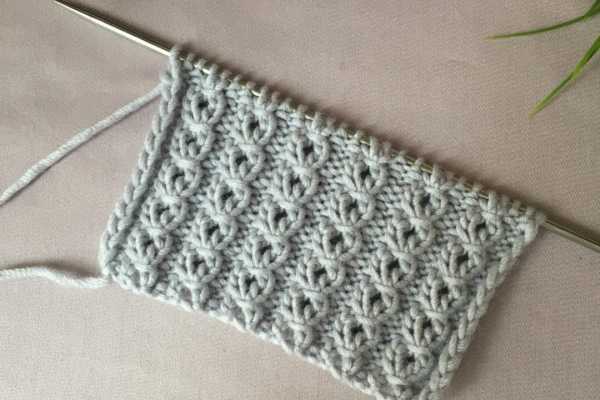
If in the patterns of simple, one-sided, French, English and other elastic bands alternating front and back loops in different variations are used, then in the openwork pattern there is always a yarn over, which ensures a kind of crossing of loops and the formation of holes that decorate the product and give it airiness.
Another difference between openwork elastic bands and simple ones is their purpose, since in addition to creating the main fabric (socks, hats and scarves), they can also be used to decorate the product - as decoration for cuffs or strips.
Tools required for work:
| Threads | Knitting products with openwork elastic can be done from thick or thin yarn, which significantly affects the appearance of the pattern. Suitable threads for work are: · Yarn from Troitsk; · Alize; · Pekhorka; · Astra Premium; · Artland. |
| Spokes | You can knit the openwork elastic band with both straight and circular knitting needles 1-2 sizes smaller than recommended by the seller. This will make the pattern more voluminous. |
| Other tools | · scissors;
· knitting marker; · needle; · ruler. |
Master classes for beginners
Openwork elastic is suitable for making both double-sided and single-sided patterns:
- the first ones are used mainly in the production of hoods, snoods and shawls, which look equally attractive from any side;
- the second can be used for knitting socks, hats and cardigans.
Double-sided for hats and shawls
Openwork elastic knitting (diagrams are given below in the article) looks the same from the front and back side is ideal for creating hats or warm shawls. Not having elasticity, it looks completely different when using yarn of different thickness.
The pattern consists of 4 loops located on one row, and it will need to be repeated when working on each subsequent circle (abbreviations used: LP - front loop, IP - back loop).
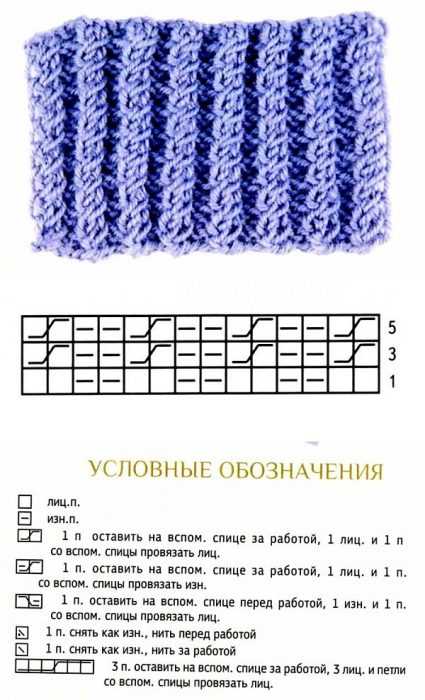
In this case, you need to:
- Cast on stitches on the knitting needles in multiples of 4 (add 2 for the edge) and to form the pattern:
- Remove the first edge loop, and place 2 LP and yarn over behind it.
- Remove the loop again, then knit the front loop and lower the unknitted loop (pass the knitted loop through it).
- Knit the pattern rapport to the end of the row, and make the last edge loop in it a purl one.
- Turn the fabric over and continue knitting, performing the specified rapport in each subsequent row.
- When knitting a shawl or hat with this pattern, it can be combined with a 2*2 elastic band, placing it in the first 2 rows. In this case, work on the pattern will begin only from the 3rd circle.
Double-sided for a shawl or a sweater
Openwork elastic knitting (pattern diagrams will help you not to get confused while working) with a double-sided pattern is ideal for creating shawls and sweaters.

It is knitted from thin woolen or semi-wool yarn using yarn overs and pulling through loops. Abbreviations used: LP – front loop, IP – back loop.
When doing it, you should:
- Cast on a row of stitches, in a quantity easily divisible by 4 (+ 2 for the edge).
- Without knitting, remove the beginning row loop onto the right knitting needle and add 2 LP.
- Make one yarn over (simply by placing the working yarn over the right needle), without knitting, slip the next stitch and work 1 LP.
- Using a knitting needle, pick up the removed loop, pull the thread through, and then slip it through the knitted front loop.
- You need to repeat the pattern rapport to the end of the working row, and then once again perform 2 LP + yarn over and a loop for knitting. After them, place another front and drop the previous one.
- Turn the product over and do the entire row in the same way. In this case, you need to finish it on the IP.
- Further work on the shawl is carried out according to the above-described pattern, while the front and back rows must be knitted in the same way.
For socks
Openwork elastic for socks is knitted in 2 threads. At the same time, experienced craftswomen advise adding synthetic yarn to woolen yarn, which will significantly increase the wear resistance of the product.
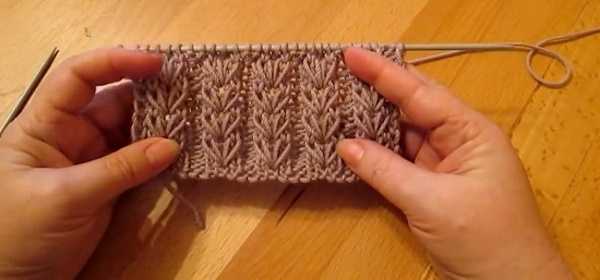
Suitable for this:
- additional sock yarn made of polypropylene (1-2 skeins);
- Schachenmayr Regia Merino Yak threads (100 g/400 m).
- straight or circular knitting needles.
Abbreviations used: LP - front loop, WP - back loop.
During work it is required:
- Using knitting needles, cast on a row of loops so that their total number can easily be divided into 5 + 4 additional ones, then:
- Having removed the first edge loop in the 1st circle (this will need to be done in each subsequent row), knit 4 rows of fabric with a 2*3 elastic band (2 LP and 3 IP). The last IP in the row is made (instead of the edge).
- Turn the product over and work according to the pattern, with each subsequent row placing the purl stitches over the LP (front loops) and vice versa.
- From the 5th row, start creating an openwork elastic band, for which the first loop in the row is removed, and then 2 IP are made after it.
- Pull up the loop from the 4th bottom row, for which you should insert the right knitting needle into it, grab the thread and, pulling it through, put it on the left knitting needle.
- Next, perform 3 LP, and then return to the place where the previous loop was pulled out, insert it into the hole, grab the thread and pull it out, forming a kind of check mark on the product.
- This rapport should be repeated 5-7 times (until the end of the circle). The last one in it will be WS (purl).
- Turn the work over, go to its wrong side and remove the edge loop, knit the next loops as front loops.
- Transfer the previously pulled loop to the right knitting needle, perform 3 IP and again remove the pulled loop (the working thread should always be behind the work).
- Following the pattern rapport, complete a row and turn the fabric over.
- In the next row, remove the edge stitch again, make 2 RP, and transfer the upper extended loop to the right knitting needle, turn it over (so that it does not twist) and return it to the left knitting needle.
- Knit 2 stitches together, then place 3 LP stitches after them, then knit the next stitch together with the slipped stitch.
- Knit the pattern to the end of the row, turn the fabric over and start the next round by knitting together first 2 LP, and then again pull the loop from the bottom row.
- Proceed in a similar manner to knit the fabric to the desired volume.
For dress and jumper
Openwork elastic knitting (patterns of the product consist of alternating front and back loops, as well as yarn overs) for a light dress or jumper, decorated with small holes, knitted from medium-thick wool yarn. For example, Azize Lana Gold with 51% acrylic addition.
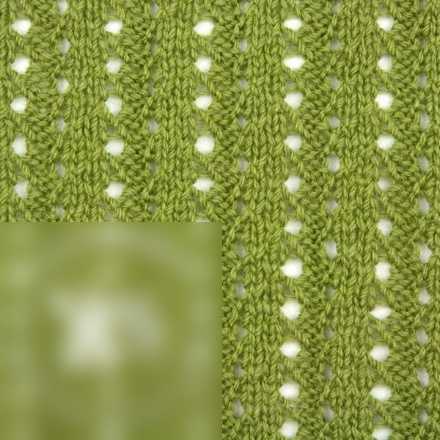
The knitted product is quite elastic and stretches well, but at the same time very light, which allows it to be used for knitting things for small children. You can use slightly thicker knitting needles for the work than the thread manufacturer recommends.
The rapport consists of 6 loops in 4 rows, and knitting begins with a cast-on row, with the total number of loops divisible by 6 (+ 2 for the edge).
Pattern repeat (abbreviations used: LP - front loop, WP - back loop):
| 1st row | 1 IP and yarn over + 2 loops picked up from above and knitted behind the front walls (tilted to the right) + 2 LP and 1 IP |
| 2nd round | 1 LP + 4 IP + 1 LP |
| 3rd row | 1 IP and 2 LP + 2 loops, turned over and knitted behind the back walls (with a left tilt) + yarn over and 1 IP |
| 4th circle | Knit in the same way as the 2nd row |
When working on a dress or jumper, the pattern will need to be repeated, each time knitting the patterns from rows 1 to 4.
Pattern diagram:
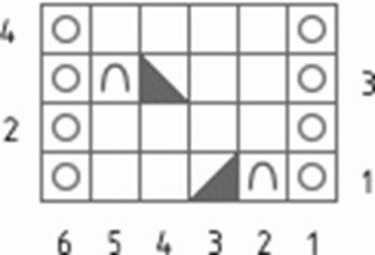
Legend:
| A front loop in the front row or a back loop in the back row. | |
| Purl stitch in the front row or front stitch in the back row. | |
| 2 loops knitted together through the front walls | |
| 2 loops knitted together through the back walls. Before this, one of them should be turned over. | |
| Yarn over |
"Rings"
The openwork elastic band "Rings" can be used to decorate cuffs or as the main fabric. It looks most advantageous when using thick wool yarn. It can also be knitted in 2 threads.
The pattern repeat consists of 4 loops in 4 rows, and work begins with a cast-on row consisting of a number of loops that is a multiple of 4 (+3). Abbreviations used: LP - front loop, IP - back loop.
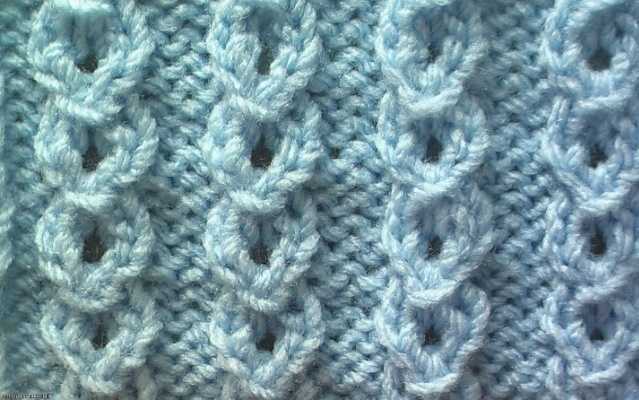
When making a drawing, you need to:
- Having removed the beginning 1st row edge loop, perform a rapport in it - 2 IP + 1 LP, yarn over (away from you) and 1 LP. It should be finished with 3 IP.
- After removing the edge loop in the 2nd row, first knit 2 LP, and then perform a repeating rapport - 3 IP + yarn over + 2 LP. It ends with a purl loop.
- 3rd row - removed edge stitch and rapport - 2 IP and 3 LP. The first of them will need to be thrown over the next 2 and pulled through it. The rapport is knitted 6-8 times, and the circle is finished with 3 IP (one of them will be the edge stitch).
- 4th round - removed edge and 2 LP, then the rapport - 2 LP and 2 IP.
- Then work on the product continues by repeating the pattern from the 1st to the 4th circle.
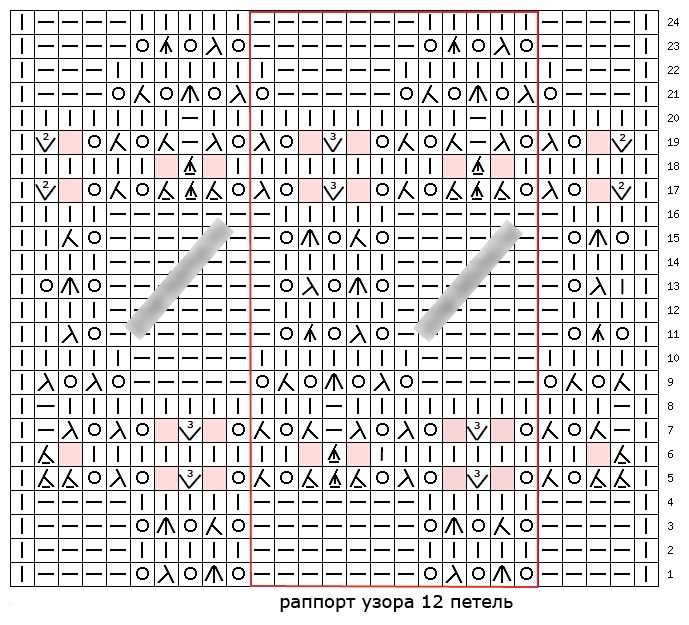
The "Rings" elastic band can be used for knitting socks, hats and scarves. At the same time, for creating warm products it is recommended to use yarn with the addition of angora wool.
After heat treatment, the thread will fluff up a little and cover small holes, allowing the product to retain body heat well and reliably protect it from cold wind and frost.
For a snood
An unusual version of the lace elastic can be used when knitting a scarf, hat or snood. It holds its shape well, is less elastic and is knitted from wool yarn (100% or with the addition of elastin or nylon).
It is recommended to work with knitting needles 1.5-2 sizes smaller. The pattern rapport has 5 loops and 2 rows, and the initial cast-on row should be a multiple of 5 (+ 3). The abbreviations used are: LP - front loop, IP - back loop.
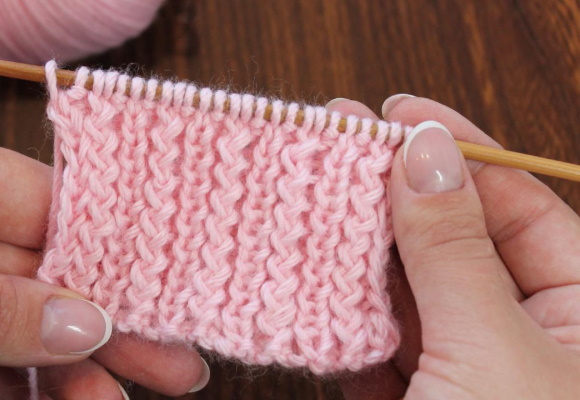
When working on a drawing you should:
- After removing the edge stitch in the 1st row, knit 1 IP + 1 LP, crossed behind the back wall and 1 IP.
- The next 2 loops are swapped, for which the first of them must be transferred unknitted to an additional knitting needle, the second loop must be made, and then the first loop must be returned and knitted together through the front walls as front loops.
- The pattern is completed until the end of the row (the last one in it will be IP).
- In the 2nd round, the edge loop is removed, after which 1 LP is made and one loop is transferred unknitted to an additional knitting needle (behind the work).
- Next, the rapport continues with 1 IP, after which the previously removed loop is returned to the left knitting needle and knitted purlwise + 1 LP and 1 crossed IP. The row ends on the LP.
- Next, the fabric is knitted to the desired length, alternating the rapports of rows 1 and 2.
From braids
Openwork elastic made of braids is an unusual and original version of a pattern that allows you to create a design with jagged edges, used both for creating strips, as well as for creating an independent canvas.
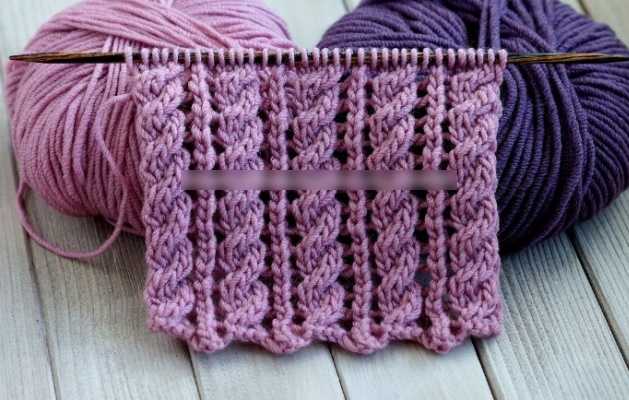
The pattern has 7 loops and 4 rows. Knitting is done in turning rows. The abbreviations used are: LP — front loop, IP — back loop.
To work, you need to complete a set row with a number of loops divisible by 7 (+ 6), and then:
- After removing the edge loop in the 1st row, perform the following rapport: 4 LP + yarn over + 2 loops, remove as if to knit + 1 LP, throw the removed loops over it + yarn over. Repeat 5-7 times. Finish the row with 4 LP.
- The 2nd round is done with purl stitch (only IP).
- In the 3rd row, first remove the edge loop and knit a repeating pattern - 2 loops, remove as on an additional knitting needle (before work), 2 LP + 2, returned from the additional knitting needle, knitted, loops + yarn over.
- Slip the next 2 stitches as if to knit + 1 LP, pass the unknitted stitches over it and make a yarn over.
- The rapport is knitted 5-7 times, after which, to complete the row, 2 loops must be transferred to an additional knitting needle (before work) and 2 LP and 2 LP knitted from the additional knitting needle must be performed.
- The 4th row is worked only with purl stitch.
- Further work on the pattern is carried out with constant repetition of the pattern of rows 1-4.
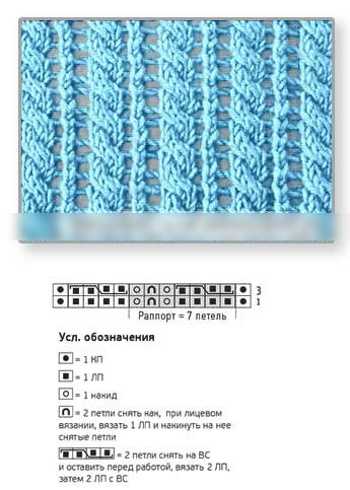
When doing this pattern in a circle you need to:
- Cast on stitches on the knitting needles in a quantity divisible by 7 and close the circle. Start working on the pattern by placing:
- In the 1st row, the rapport is 4 LP + yarn over + 2 loops, slip as if to knit + 2 LP, throw the slipped loops over them and make a yarn over.
- 2nd round - knit with stocking stitch (front loop only).
- The 3rd row is done according to the pattern - 2 loops removed to an additional knitting needle (before work) + 2 LP + 2 loops knitted together from the additional knitting needle + yarn over + 2 loops removed as in knitting + 1 LP with the removed loops thrown over it + yarn over.
- The 4th round is done with the front surface only.
- Subsequently, the work involves repeating the patterns from the 1st to the 4th row.
3D
An elegant and stylish variation of the openwork elastic band will also be made in 3D format. The new, unique technique involves combining an openwork pattern with elements of a simple elastic band and is suitable for knitting fashionable and elegant women's spring and summer pullovers, as well as shawls.

It can also be combined with rows made with the front and back surface. You can use any yarn and circular knitting needles for work. The pattern rapport consists of 4 loops and 11 rows.
When performing it, you should (abbreviations used: LP - front loop, IP - back loop):
- Cast on a row of stitches with knitting needles, red 4 (+1) and close the knitting in a circle.
- In the 1st and 2nd rows, first perform 1 IP, and then the rapport - 2 LP and 2 IP. Both rows end with a knitted edge loop.
- To form an openwork pattern, place the following pattern in the 3rd row: 2 LP knitted together + 2 yarn overs + 2 LP knitted together with a left tilt. To make the tilt, transfer 1 loop to an additional knitting needle as a front loop, make a new loop in the row and pull it through the removed loop.
- In the 4th row place a 2*2 elastic band (2 LP + 2 IP).
- in the 5th round, place 1 LP and 2 IP, and then perform a crossing of the front loops, for which the first LP is removed to an additional knitting needle (before work), the second is knitted as a front one, and after it, the LP is placed, returned from the additional knitting needle.
- In the 6th row, a 2*2 elastic band is worked.
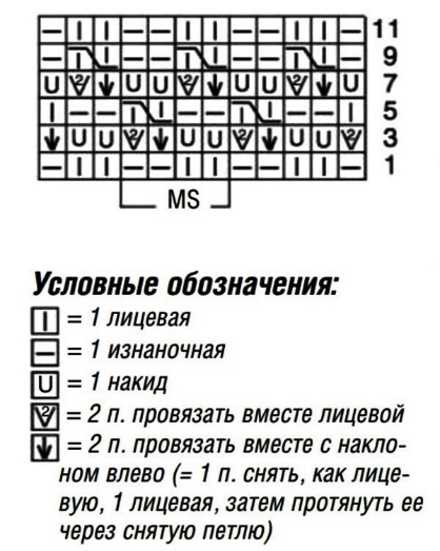
- The 7th row should be started with a yarn over, and then continue by knitting the rapport - 2 loops knitted together with a left tilt, 2 LPs knitted together and 2 yarn overs.
- In the 8th row, a 2*2 elastic band is placed, and the 9th row begins with the 9th, first 1 IP is placed, and then the rapport is placed - 2 crossed LP and 2 IP.
- in the 10th and 11th rows the elastic pattern 2 LP + 2 IP is used.
- Subsequent work on the product continues with alternate knitting of the pattern from the 1st to the 11th rows.
With dropped loops
Openwork elastic knitting (patterns of the product may vary depending on the type of pattern and include additional elements) with dropped loops is used to create spectacular spring women's and children's items (jumpers, dresses, cardigans).
Acrylic yarn is suitable for this type of knitting, for example, Diva Azize (with 100% microfiber and acrylic content) or Superlana Midi Alize (with 75% acrylic content and 25% wool). It is best to use fairly thick knitting needles for this type of work.
Work scheme:
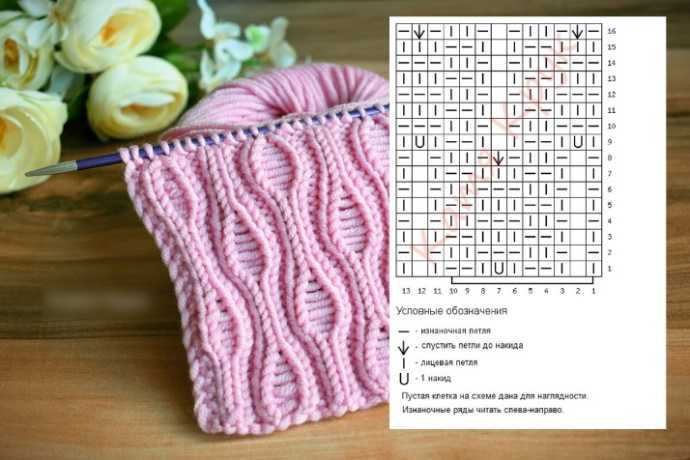
The pattern repeat consists of 8 loops and 16 rows (abbreviations used: LP - front loop, WP - back loop).
When making a drawing, you need to:
- Using knitting needles, cast on a row of stitches divisible by 8 (+ 2 extra for turning rows) and do the following:
- 1st round with the following pattern: 2 LP + 2 IP + 1 LP and yarn over + 1 LP and 2 IP. Finish with face stitches.
- When performing the 2nd and 10th rows, the pattern indicated in the diagram is used, while all the yarn overs knitted in them from the previous rows are performed with purl loops.
- From the 3rd to the 7th row, knit the elastic band according to the pattern.
- The 8th row begins with 2 IP, and in a circle 5-7 times the rapport is knitted - 2 LP + 1 IP, lower the loops to the yarn over and perform 1 IP, 2 LP and 2 IP.
- The rapport of the 9th row is 1 LP + yarn over + 1 LP + 2 IP + 2 LP + 2 IP. You need to repeat it along the entire row (5-7 times) and finish it with 2 front loops and a yarn over located between them (1 LP + yarn over + 1 LP).
- Row 16 starts with 1 IP, the next loop needs to be dropped to the yarn over and knit another 1 IP, after which you need to move on to performing the pattern rapport - 2 LP + 2 IP + 2 LP + 1 IP, drop the next loop to the yarn over and perform 1 IP. You need to knit the rapport until the end of the working row.
- When knitting the fabric further, the pattern is repeated from the 1st to the 16th row until the product reaches the desired size.
You can knit a light jumper or dress with an openwork elastic band using a pattern with a rapport of 8 loops (+6 and 2).
Pattern diagram with front rows:
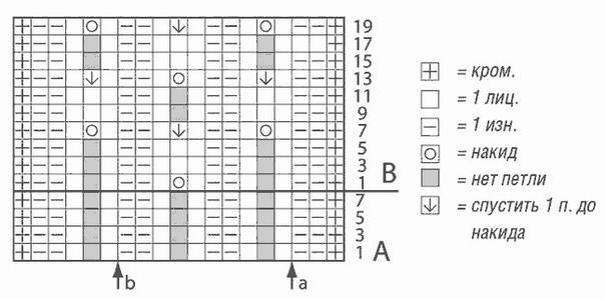
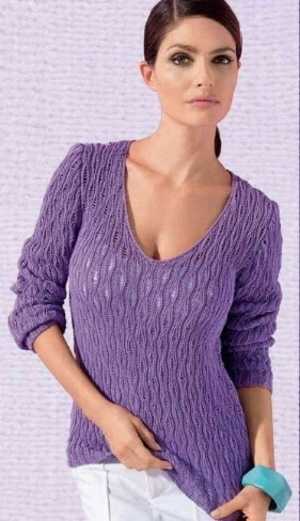
When knitting purl rows, a pattern is also used, and:
- It starts according to the pattern indicated on the diagram by the letter A, for which from the 1st to the 8th row (section A-B on the diagram) when knitting the fabric you should use a simple pattern 3*3 (3 front and 3 back loops).
- From the 9th row, you can start knitting an openwork pattern with dropped loops according to the pattern indicated on the diagram by the letter B. It is knitted up to the 20th row.
- Starting from the 21st row, when knitting the fabric, you will need to repeat the pattern from the 1st to the 20th rows.
Tips and tricks
Openwork elastic is a fairly simple pattern to make, when knitting which experts recommend:
- Use only high-quality yarn, choosing it depending on the type of product. For warm knitted items - hats, scarves and socks, it is recommended to use thick wool yarn with the addition of synthetic fiber.

It is also desirable that the threads contain angora, which will allow the threads to fluff up a little after heat treatment and cover the holes from the yarn overs.
It is best to knit such items on knitting needles of a smaller size than recommended by the manufacturer, which will make the pattern more voluminous and embossed.
- For summer items, you can use both thin woolen threads and cotton yarn. However, it is best to use thick knitting needles for knitting.
- Knit openwork elastic on straight or circular knitting needles, and to use the latter, you will not need to add 2 loops to the total set to form the edge. In this case, only one loop is added to the recommended number to connect the knitting in a circle.
- If you don't have enough experience, use simpler patterns for knitting, carefully reading the diagrams and always monitoring the rapport being performed. Later, you can try to make more complex versions of openwork elastic.

- When knitting in the round, it is essential to use a marker to mark the beginning and end of each row. It will also be useful in cases where you need to urgently put knitting aside without knitting the entire working row.
- Get a notebook or a workbook, which will contain all the patterns used in knitting, calculations, the set of loops made, additional increases and decreases. It is also necessary to glue in it the labels removed from the skein of thread.
Openwork elastic is a beautiful, voluminous and elegant pattern used both for knitting the main fabric and for creating cuffs and straps.
Performed with knitting needles according to a pattern consisting of front, back loops and yarn overs, it involves the use of wool (any density), acrylic or cotton yarn and knitting needles selected depending on the type of thread and the type of desired product.
Video about knitting
Openwork elastic band with knitting needles:
